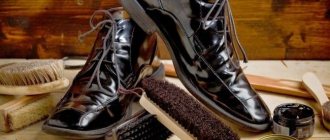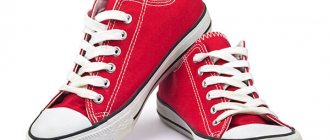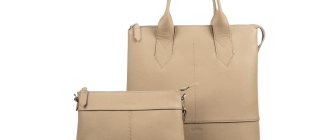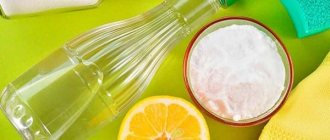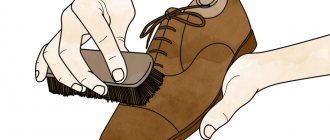The quality of shoes should not be neglected, as it affects the health of the legs and spine. Leather wins on all counts: it looks expensive, is more wear-resistant, and allows the feet to “breathe.” Of course, I would like my favorite pair to last as long as possible. This article contains tips on how to properly care for leather shoes.
Stages of care
If you think that you don’t need to take care of natural leather until a problem appears, you are deeply mistaken. Proper care includes:
- Cleaning the outer surface on which the main contaminants accumulate.
- Cleaning the “internals” and insoles.
- The washing up.
- Drying.
- Application of nourishing and caring agents, moisture-repellent impregnation.
Advice! The main principle that must be observed is regularity. You should not put off washing until later, otherwise the dirt may become so embedded that it will be impossible to clean it.
Cleaning
Before cleaning leather shoes, let's figure out what we need for this. The set of tools is as follows:
- Soft cloths.
- Soft brushes.
- Felt.
- Velor sponges.
The sole can be cleaned with a brush or the hard side of a sponge, but do not press too hard, otherwise the shoe, due to the damaged pattern, will become less comfortable and slippery.
It is necessary to care for leather shoes immediately after wearing them. As soon as you get home, use a soft brush to brush away any dust and dirt that may have stuck during your walk. For small or hard-to-reach parts, you can use a toothbrush. This procedure prevents stubborn stains from appearing, which are very difficult to remove. Even if the shoes are not in use, they must be wiped every 2-3 days, as dust accumulates on the surface.
Then you need to take a cleaning solution or soap and clean the skin, rinse off the foam, and dry at room temperature.
Important! Leather shoes should not be placed on or near radiators, as they will dry out and become deformed at high temperatures.
Don't forget about the insoles. They get as dirty as the shoes themselves, especially if the shoes are open. First you need to clean the dust with a damp cloth. Insoles made from regular material can be cleaned with soap and water. But only baby cream is suitable for leather products, since when cleansed with other means they become hard and lose their shape. After cleaning, remove any residue with a damp cloth. When the insoles dry, they will become clean and pleasant to the touch.
The washing up
This step is needed only if the dirt is very strong and cannot be removed with a sponge or rag.
It is, of course, better to wash leather shoes by hand, since such exposure will cause less damage. To do this you need:
- Remove all removable parts: insoles, laces, accessories that are removable or can damage the shoes when washed.
- Remove dust with a dry cloth and then a damp one to remove any remaining dirt. Don't forget about the soles.
- Wash the inside of the boots.
- Wipe shoes with a solution of ammonia in water (5 drops per glass).
- Rinse off the liquid and leave the leather item to dry.
Attention! Shoe manufacturers categorically do not recommend washing genuine leather shoes in a washing machine. This is a big risk, since it will most likely become deformed, fade, and become stiff.
Machine washing should be used only as a last resort if the product would not be a pity to throw away in case of damage. The washing rules are as follows:
- If shoes are glued and not stitched, they should not be washed under running water or washed. Otherwise, the glue may dissolve.
- Before washing, place the leather item in a shoe washing bag or wrap it in an old sheet. The chance of damaging the machine will be significantly reduced.
- It is better not to put items in the washing machine if they have a lot of metal inserts and accessories.
- Suede shoes should not be washed.
Attention! Do not raise the water temperature above 40°. When washing in an automatic machine, it is advisable to select the “for delicate fabrics” or “quick 30°” mode, and set the speed to minimum at the same time as the time.
Of course, it is better not to bring your shoes to such a state that they require washing, especially machine washing. This is a lot of stress for the product.
Drying
After washing the skin, you need to dry it. If you wiped your shoes with a damp cloth, simply go over the surface with a paper towel.
Leather shoes should not be dried at high temperatures, under the rays of the sun, or near radiators or heaters. To prevent shoes or boots from losing their shape, you should put crumpled paper inside.
Attention! If the leather is light, you should not put newspaper or any other paper with colored inserts in it, as the shoes may become stained.
Applying care products
Caring for genuine leather products does not end with drying. After this stage, it is necessary to apply caring nutrients. You need to take care of the leather of your shoes as carefully as you would your own. There are such care products as:
- Crema. Moisturize and nourish the skin.
- Impregnations. Repel moisture, preventing getting wet.
- Sprays. They can be either water-repellent or moisturizing.
- Waxes. Gives shine.
- Color restoring paints.
Of course, you can even buy them in a regular supermarket for pennies. However, if you would like to wear a pair of shoes for as long as possible, do not skimp on care products. You should buy them in shoe stores from trusted manufacturers.
Advice! After purchasing a new pair of leather, you should immediately apply moisturizer to it.
Storage
Few shoes are worn all year round; most of them have to be put aside until the next season. If the storage conditions are violated, the shoes may become deformed, fade, or acquire stubborn stains. To prevent this from happening, you should follow the rules:
- Before putting them away for storage, thoroughly clean your shoes, wash them if necessary, and lubricate them with care products.
- Pads will help prevent deformation, and if there are none, use crumpled paper that needs to be placed inside the product.
- Leather shoes should be stored in a box or bag made of natural material, not in plastic bags.
- In summer, shoes should not be kept outside, especially in direct sunlight, they can fade and crack.
Popular manufacturers
The ranking of the best shoe product brands is topped by:
- Salamander. A well-known German manufacturer, initially engaged in sewing shoes, boots, boots. Gradually, the range of products expanded, a line of shoe care products appeared - high-quality, reliable, modern. All forms of products produced have proven themselves well. Popular products are: Salamander Glattleder sponge, Wetter Schutz cream No. 033, Bick Salamander water-repellent wax coating.
- Kiwi. The products are characterized by a huge range and the use of the latest technologies. The most popular are: Shoe Polish cream in a jar, Express Shine sponge with dispenser, Shine-Protekt liquid cream-gloss.
- Kari. The shoe brand offers high-quality leather care products. The cream, water-repellent spray, and Kari restoring paint are well known.
- NikiLine. Of particular interest is the spray produced by the manufacturer. NikiLine product for suede and nubuck is colorless, without a strong odor, and non-sticky.
Salamander
Kiwi
Kari
NikiLine
Among polishes, the following are in high demand:
- Kangaroo, which is intended for polishing the surface of a car, but is great for polishing leather shoes.
- Collonil, used for smooth leather products. Created on the basis of lanolin.
- Saphir is a quality product for polishing patent leather shoes.
Erasers that have proven themselves on the market:
- Salton – cleanses the surface of suede, nubuck, velor well, eliminates grease;
- Solitaire is a universal product for all skin types;
- Saphir – cleans stains on suede and nubuck, restores the structure of the product;
- Collonil – delicately treats soft velor and nubuck.
Regardless of the material, in order for the product to last for a long time, you need to keep it clean, use special products, dry it at natural temperature and store it in a dry, dark place.
The choice of modern shoe care products is varied. Having studied some of the nuances, you can choose a product that will retain the attractive appearance of the product for a long time. The main thing is to approach the process responsibly.
Salton
Solitaire
Saphir
Collonil
Products for leather shoes
The condition of the skin depends on the quality of care products. With their help, your shoes will look like new for a long time.
Professional
To clean, nourish and polish your skin, you will need:
- Cleansing shampoos and foams. There are quite a lot of them: Reno Mat, KIWI, Twist, Salton and others. Such products help remove dirt and remove old stains.
- Nourishing creams or caring cosmetics. There is a very large choice here: Twist, Vilo, Salton, Tarrago, as well as many others, freely sold in any shoe store. If the cream is of high quality, it is enough to use it 1-2 times a month. It must be applied to a brush (which is most often included) or a cloth, then polish the surface. Shoes should be left to dry at room temperature. After this procedure, the skin will be smooth and soft, without cracking.
- Polish with wax. It helps to achieve shine and radiance, and serves as protection against moisture.
- Spray paint. This product helps to paint over scratches and other damage where the paint has come off, and removes faded stains.
Folk
Folk remedies are no less effective than professional ones:
- A solution of soda in water (2 tsp per 1 tbsp) will remove stains of dirt and grease. It is necessary to soak a cloth in the liquid and wipe the surface until foam appears. Then use a dry cloth to remove any remaining liquid and dry the skin.
- Mix table vinegar 9% with water in a ratio of 3:1, rub into the stain, rinse off after 2-3 minutes. This method will clean leather shoes from salt and stains.
- Old cream can be removed with turpentine or gasoline. You just need to wipe your shoes once a week with a cloth soaked in the selected substance.
- Toothpaste will cope with stains not only on normal skin, but also on white skin. It is necessary to rub the desired area with a brush, and then rinse off the remaining paste.
- Flax oil applied at night will help remove dirty stains. In the morning you need to polish your shoes until they shine.
- Milk, egg and sugar should be taken in equal proportions and whipped until white foam forms. Then you need to apply the mixture to your shoes, leave for half an hour and rinse off.
- Castor oil, sold in any pharmacy, is suitable for nourishing the skin. It should be rubbed into shoes, this will give them shine and protect them from cracks.
- You can also use an ointment made from castor oil, linseed oil and beeswax mixed in a ratio of 8:1:1. Rub the skin thoroughly with a cotton pad on which the mixture is applied, wait until completely absorbed, and then repeat the procedure.
Water-repellent impregnations
Water-repellent impregnations are used to protect shoes from getting wet. They cover the surface with a thin layer so that it is protected from moisture, but “breathes” just as well as before.
Water repellents are as follows:
- Impregnation. Products containing fluoride can be used for any type of shoes. Impregnations with fluorocarbon resin are suitable for suede and nubuck. Silicone is considered a favorite among owners of leather shoes, as it does not allow water to even slightly wet the leather. The impregnation begins to act only 9-10 hours after application, so it is better to treat shoes in the evening.
- Water-repellent spray is the most convenient to use because it does not require additional brushes or sponges. Plus - it retains color. It also has a downside - a very unpleasant, pungent odor, so it should be applied in the fresh air or in a well-ventilated area.
- Creams. Their advantage is that, in addition to repelling moisture, they moisturize the skin and protect it from cracks.
- Unsalted lard, which should be used to rub shoes. It will protect your shoes from both moisture and frost.
Use specialized care products
They can be purchased from the same shoe store where you purchased your pair. Ideal if you get this set:
- Cleaning agent. It is usually sold in the form of shampoo or foam.
- Cream. These products contain fats or oils that maintain the natural level of moisture in the skin and make it soft and elastic. Creams are available with different pigments (there are other options besides black, white and brown), and they need to be selected to match the color of a particular pair.
- Polish. This is a silicone-based product that, when applied, adds shine to the leather surface.
- Impregnation. This is a protective water-repellent spray that increases the wear resistance of shoes.
- Brush for footwear. Choose a tool with soft bristles. If you have several pairs of leather shoes of different colors, you will have to get a separate brush for each.
- Spacers-form holders. They are necessary for drying and storing leather shoes.
How to care for white shoes?
Caring for white leather shoes requires following several rules and tips:
- Light-colored shoes should be stored separately from colored ones.
- To care for white leather, use separate tools.
- To ensure that no dark stains remain after cleaning, you must first wipe the dust with a rag, and then clean the surface with a cloth soaked in a solution of washing powder.
- Transparent or white cream is applied first to the brush and only then to the shoes themselves.
- White toothpaste can easily remove stains on leather shoes. It is necessary to thoroughly wipe the skin with a brush, then rinse off the residue with water.
For varnished
Taking care of leather shoes with a patent leather surface is a very difficult task. The glossy finish can crack and fade, causing the shoe's appearance to suffer greatly. To extend their service life, follow the recommendations:
- Clean it daily from dust and other contaminants using a soft, damp sponge or disk soaked in milk;
- periodically polish with castor oil, glycerin or petroleum jelly - this approach will help maintain the glossy varnish layer for as long as possible;
- to enhance the glossy shine, you can periodically treat genuine leather models with a little beaten egg white;
- use specialized products for the care of footwear of this type (water-based), because ordinary ones can disrupt the structure of their pores, as a result of which boots or shoes lose their shine;
- Do not use a brush to wipe the varnished pair.
Tricks for caring for patent leather
How to soften leather shoes?
To soften the skin, prepare an ointment consisting of baby cream and beeswax. It is necessary to mix the ingredients in equal proportions, apply the resulting mixture to the product, rub well and rinse off after a few minutes. If you can't get wax, use only cream. Castor or linseed oil, Vaseline or glycerin will also help make shoes softer. If the previous methods don't work, try gently warming up your shoes with a hairdryer or holding them over steam and then walking around in them until they cool down. Use this method as a last resort, as temperature changes can damage your shoes.
How to restore shoes?
If your shoes are scratched or cracked, you should know how to restore them. The classic remedy in such cases is shoe polish. This is an ointment based on wax and oil. Helps hide scratches and minor imperfections and add shine.
Cracks and even loose pieces of leather can be repaired yourself using glue or clear nail polish. The selected substance must be applied to the back of the peeled leather, pressed firmly onto the shoes, and wait a few minutes. Scratches are repaired in the same way, only glue is applied directly to the crack and its edges are tightly connected.
A knocked toe is restored using fine-grained sandpaper. It is necessary to polish the shoes using light pressure.
To consolidate the result, you should treat leather shoes with wax or cream.
Cleansing
Try to use dry cleaning foams for cleaning. If you wash shoes made of genuine leather “under the tap”, all the beneficial substances that maintain their elasticity will be washed away.
1.
Apply foam to the surface to be treated. Rub with a brush or cloth until the dirt and foam completely disappear.
2.
Remove dirty foam with a dry, clean cloth. Before the next step, the shoes must be completely dry (~30 minutes).
IMPORTANT:
Be sure to test all cleaners in a hidden area for the quality of the shoe dye.
How to distinguish leather from leatherette?
Now you can very accurately fake any material. If you do not want to fall for the tricks of scammers, you need to be able to distinguish between genuine leather and artificial leather. Here are a few signs that help you do this:
- Thickness. Natural leather is usually thicker and its edges are rougher.
- Elasticity. If you press on the natural material, it will become covered with small wrinkles, but will quickly return to its original state.
- Color. When bent and other manipulations, a leatherette product can change shade, which leather shoes will not do.
- Pores. With natural material they will never be located at the same distance. But the pores of leatherette are very smooth.
Useful tips and tricks
- Do not leave leather shoes near heating appliances or in the sun.
- Clean your shoes in a timely manner and take care of them regularly.
- Do not twist the backs when putting on and taking off shoes.
- It is advisable to have at least two pairs for the season, since wet skin takes more than a day to dry. Do not wear wet or damp shoes.
- Summer sandals should not be worn in the cold season, and winter boots will be inappropriate in warm weather. The main rule for using leather is to wear it according to the weather.
Maintenance during use: cleaning and drying
You need to take care of your shoes at home twice – before going outside and after returning home. If dirt gets on your shoes during the mid-season or winter, it should be washed off with a soft cloth soaked in warm water. Materials such as calico or flannel work well; you can also use the soft side of a sponge. Using this principle, both the top of the shoe and its sole are cleaned.
The next stage is drying the shoes, since the leather needs to be protected from moisture in time.
After washing the shoes, wipe them dry with a soft cloth and leave them to dry naturally. You cannot use heaters and artificial devices, such as electric dryers, for these purposes, as this will damage the integrity of the skin and its external attractiveness. Advice! When drying shoes, you can use spacers or crumpled newspaper rolls, pushing them inside the shoes. This will help the boots or shoes maintain their normal shape without creases or dents.
